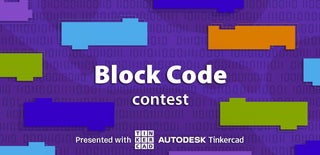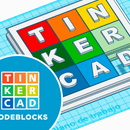Introduction: How to Design and 3D Print Flexible Meshes
In this Instructable, you will learn how to use Tinkercad Codeblocks and Tinkercad 3D designs to create flexible meshes. Whether you are new to Tinkercad or have some experience, this instructable will guide you through the process of designing and 3D printing flexible modular surfaces (also known as "3d printing fabric" or "3d printing textiles") that can be used in a variety of projects.
Upon completion of this project, you will be familiar with four techniques for leveraging the bridging capability of fused filament 3D printers. These techniques will enable you to produce interconnected modules without the need for structural supports, forming a flexible grid or a bendable lattice geometry.
So, get ready to expand your Tinkercad skills and create something unique and functional!
Supplies
Software CAD/CAM:
- Autodesk Tinkercad 3D Designs (to align the tile modules)
- Autodesk Tinkercad codeblocks (to create the tiles with their connectors)
- Ultimaker Cura 5.2.1 (for 3D Printing)
Materials and tools:
- PLA 1.75 mm (I used a PLA silk rainbow that changes color as you print, but you can use any other type of PLA)
- Scraper
- Cutting tweezers
Rapid prototyping machines:
- 3D Printer (I use a CR-10S from Creality)
Step 1: Design Rules for 3D Printing
The 3D design rules from 3D Hubs are a set of guidelines designed to help ensure successful 3D printing of digital designs. These rules provide recommendations for factors such as design simplicity, orientation, tolerance, wall thickness, infill, and support structures.
The goal of these rules is to help 3D designers create models that can be successfully printed, with good structural integrity and appearance, and without the need for excessive material or support structures. By following these guidelines, designers can optimize their designs for 3D printing, improve the quality of the finished product, and streamline the 3D printing process.
But instead of seeing the rules as a restriction, let's see them as an advantage; taking their qualities and using them to our favor to make functional parts.
Below are the full-scale 3D models I made with Tinkercad 3D Designs based on the HUBS poster "Design Rules for 3D Printing". You can use it as a reference in your projects to verify that your 3D models adhere to the design guidelines and also you can get your own copy of the poster by requesting it through the official HUBS website: here.
For this project, the most "restrictive" rules in our design will be:
- Horizontal bridges
- Overhangs
- Pin diameter & small features
_
Design Rules from 3D Printing
Step 2: Bridging or "Living Bridges"
Bridging refers to 3D printing plastic that spans between two points without support. For shorter bridges, support structures may not be necessary, saving material and time. The plastic is extruded across the gap and rapidly cooled to form a solid bond. *To achieve successful bridging, proper printer calibration and settings are crucial.
This opens up vast design opportunities, as it enables us to 3D print interconnected "stitches" without having to print separate pieces and glue them together. And the best part? It can be done without requiring any support structures!
Step 3: 45°~60°, 90° & 180° Degrees Bridging
It is possible to create clamps or grips using the 3D design rules from 3D Hubs by following these guidelines:
- Bridges must not have a void space greater than 10mm
- Bridges must be thicker than 2mm (square profile) or 3mm radius (cylinder)
- You can use a straight, round or ovoid profile.
- Rotating the clamp at an angle between 45° and 90° will eliminate the need for support structures.
By combining these rules and choosing the right geometric shapes, it is possible to create interconnected meshes without the need for structural supports. This allows for greater design flexibility and improved print quality.
But first, in order to achieve the desired result, it is important to choose the right geometric shape for your grid.
Bridging in 3D Printing
Step 4: Visualize Your Pattern
This project is a decision-making game where you must choose two key aspects: (1) the geometric shape to fill your net, and (2) the type of staple to connect the tiles together.
By perfectly aligning geometrical figures we form lattices or tesellations. A tessellation is a repeating pattern of shapes that completely covers a surface without any gaps or overlaps. It can be thought of as a mosaic made of identical shapes.
The term is often used in mathematics and refers to the process of tiling a plane with shapes.
Step 5: Combining Bridges 90° + 180°
This module design is simple to create, however, it poses a challenge during printing. The issue is that the connection point between tiles is a small ring that floats between them. To 3d print correctly, it "should" needs support underneath it.
The solution is to have a gap of 0.2 to 0.3 mm between the ring and the previous layer so that the filament can rest on it without adhering.
Link to the module in codeblocks: here
_
Flexible Mesh V1
Step 6: Combining Bridges 90° + 45°~60°
This design offers greater post-printing flexibility due to the wide range of angle play between the staples, allowing them to move with ease.
Link to the module in codeblocks: here
_
Flexible Mesh V2
Step 7: Combining Bridges 45° + 45°
This model boasts the neatest appearance and durability. Observe how the staples are not centered on each side of the hexagon, they are slightly angled towards one end, enabling a repeating radial pattern.
Link to the module in codeblocks: here
_
Flexible Mesh V3
Step 8: Radial Bridges 45°~60°
This design takes inspiration from a NASA experiment, featuring oval grips with their radii aligned towards the radius of the hexagon. This results in a larger handle opening, allowing for smaller tiles. However, it demands precise alignment when creating the pattern.
Link to the module in codeblocks: here
_
Flexible Mesh V4
Step 9: Array and Constraints
Codeblocks is a useful tool for designing individual tile modules as it enables quick design modifications through parameter changes, eliminating the need to start from scratch when customizing the module.
Alternatively, you can use Tinkercad 3D designs to import individual module STLs and utilize the duplicate tool (Ctrl + D) to create patterns efficiently while ensuring proper alignment.
There are two crucial considerations to keep in mind:
- All tiles must have the same exact spacing between them.
- The staples must never touch each other, always maintaining a small gap to keep them apart.
Step 10: Scaling and 3D Print Settings
When it comes to scaling the model, you must consider the smallest possible size for the modules and the feasibility of the scaling. To determine this, you need to experiment with the G-code and the 3D print's functionality.
As a general recommendation:
- To make the figure smaller, ensure that the staple thickness is at least equal to 1 outer perimeter + 1 inner perimeter (approximately 1.6 mm).
- And to make the model bigger, ensure that the distance under the bridges is no more than 10 mm.
- Do not activate the supports function when performing the gcode (these could affect the prototype functionality)
Since you are working with strict rules and small tolerances you should make sure to print your model in high qualities (between 0.10 and 0.20 mm layer thickness). The parameters that worked for me in this experiments were:
- Material: PLA Silk Rainbow
- Nozzle size: 0.4 mm
- Layer quality: 0.20 mm
- Wall line count: 4
- Infill: 100% grid pattern
- Extrusion temperature: 210 C
- Hot bed temperature: 60 C
- Printing speed: 45 mm/s
- Supports: No
- Adhesion: Brim (3 outlines)
Step 11: 3D Print It! and Test It!
Step 12: The Future of the Textile Industry?
In the images above we can see the designs of Raul Polit Casillas, a systems engineer at NASA's Jet Propulsion Laboratory in Pasadena, California. He and his colleagues are designing advanced woven metal fabrics for use in space.
Foldable and shape-changing properties make these fabrics ideal for use in large antennas and other deployable devices. They could also protect spacecraft from meteorites, serve as spacesuits for astronauts, or capture objects on other planets. For instance, they could insulate a spacecraft exploring an icy moon like Europa while still adapting to uneven terrain without melting the ice beneath it.
This design-centric approach has the potential to transform the engineering of industries. Instead of relying on multiple individual components that increase the risk of failure, the future industry could be constructed as a unified entity, offering added functionality.
Another potential uses of 3D printing fabrics and flexible meshes in various industries are:
- Soft Robotics: 3D printing flexible materials can be used to create soft and bendable robots that can be used in various industries such as healthcare, manufacturing, and entertainment.
- Wearable Technology: 3D printed fabrics can be used to create smart clothing and wearable technology such as fitness trackers, health monitors, and more.
- Medical Devices: 3D printed flexible materials can be used to create custom-fit prosthetics, orthotics, and other medical devices that are comfortable to wear and provide support.
- Consumer Products: 3D printing flexible meshes can be used to create innovative consumer products such as handbags, footwear, and more that are comfortable and functional.
- Aerospace and Automotive: 3D printing flexible materials can be used in the aerospace and automotive industries to create lightweight and flexible parts that improve efficiency and performance.
At completion, I hope that this tutorial has helped you understand the potential of 3D printing fabrics and flexible meshes, and has given you the tools to create your own designs using Tinkercad Codeblocks and 3D designs. Whether you are interested in soft robotics, wearable technology, medical devices, consumer products, or any other industry, the possibilities are endless with 3D printing. I encourage you to continue exploring and experimenting with this exciting technology, and to share your creations with us.
Step 13: References
Poor bridging. (n.d.). Simplify3D. https://www.simplify3d.com/resources/print-quality-troubleshooting/poor-bridging/
“Space Fabric” Links Fashion and Engineering. (n.d.). NASA. https://www.nasa.gov/feature/jpl/space-fabric-links-fashion-and-engineering/
3D printing design rules poster. (n.d.). Hubs. https://www.hubs.com/get/3d-printing-design-rules/

Participated in the
Block Code Contest













